Purple-blooming shrubs are a great way to bring gorgeous hues to your garden. Exciting colour combinations are created by the contrast between the vibrant purple shrubs and the lush green foliage.
Choose flowering shrubs that are appropriate for your growing zone, daily sunshine hours, and soil type. To save your time in gardening, it’s also preferable to choose shrubs that require little maintenance.
The most beautiful purple landscape bushes, plants, and shrubs for your garden landscape are all covered in detail in this article. Furthermore, images of purple flowering shrubs could help you to pick ideal plants for placing around your home.
1. Butterfly bush

Scientific name: Buddleja davidii
USDA zone: 5 to 9
Plant Size: 5 to 10 feet apart
Sun Exposure: Full sun
The beautiful purple flower blooms in a conical shape are what identify the butterfly bush. The purple evergreen bushes bloom in the middle of summer. The spherical shrub is covered in clusters of stunning lilac-coloured flowers that release lovely scents and draw butterflies.
These easily-grown, pink, or purple blossoms attract pollinators. Any variety of butterfly shrubs works well for perennial borders, cottage gardens, foundation planting, and container gardening.
2. Lavender

Scientific name: Lavandula angustifolia
USDA zone: 5 to 9
Plant Size: 2 to 3 ft. (0.6 – 1 m) tall
Sun Exposure: full sunlight
Think about growing this well-known “queen of the herbs” as a hedge shrub! It thrives close to any kind of plant in your herb, veggie, or flower garden. There are also lots of lavender varieties available, Depending on your climate.
Lavender’s beautiful purple colour, strong scent, and simplicity of growing have made it a garden classic. Additionally, pollinators like it. Grow it in soil that drains properly.
3. Clematis
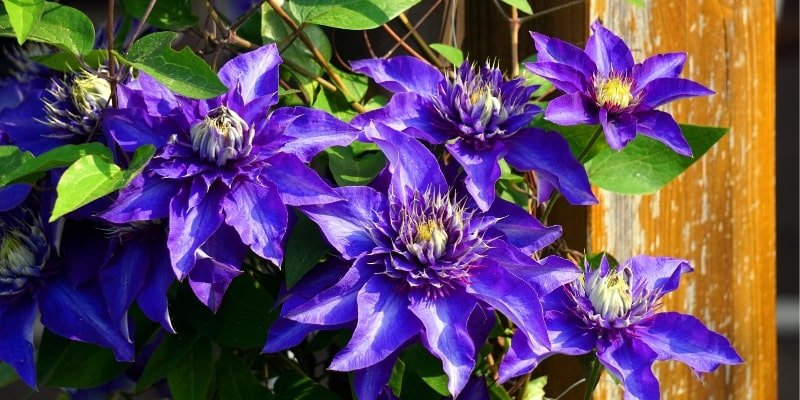
Scientific name: Clematis ‘Betty Corning’
USDA zone: 4 to 9
Plant Size: 4-10 feet tall
Sun Exposure: full sun
Clematis is a family of flowering vines, though some varieties can be grown as shrubs with deep purple flowers. Herbaceous clematis is a kind of perennial that forms clumps and resembles climbing types in both its blooms and foliage. Four or five curving purple petals grace the bell-shaped, hanging flowers that appear in the summer and fall.
Many of the species found in warmer climates are evergreen, whereas the cool-tempered ones are deciduous. Full sun and cold, wet, well-drained soil is ideal for their growth.
4. Hydrangea

Scientific name: Hydrangea macrophylla
USDA zone: 5 to 9
Plant Size: 4-15 feet tall
Sun Exposure: full sun
Hydrangea bushes are not only gorgeous, but they are also among the few plants that can be maintained in most climates from coast to coast.
The acidity of the soil can alter the colour of Hydrangea macrophylla. Kits containing sulphur or aluminium sulphate are available for purchase to adjust the pH of soil. A pH between 6 and 7 causes them to turn pure purple or pink-purple, according to the basic rule.
5. Petunia
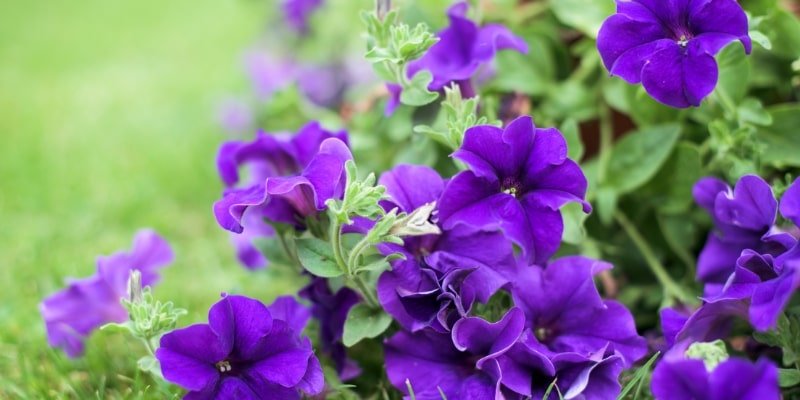
Scientific name: Petunia
USDA zone: 10 to 11
Plant Size: 6 inches to 18 inches
Sun Exposure: partial full sun
The majority of petunia species are annual herbs. The leaves are smooth-edged, oval-shaped, and sessile some even have tiny, sticky hairs. Five united or partially merged petals and five green sepals make up the funnel-shaped flowers.
The common garden petunia is a popular ornamental plant for summer flower gardens and window boxes because of its stunning trumpet-shaped flowers.
6. Wisteria

Scientific name: Wisteria Sinensis
USDA zone: 5 to 8
Plant Size: 10-40 ft. tall, 4-30 ft. wide
Sun Exposure: full sun
In spring, wisteria blooms heavily making clusters of lilac-coloured flowers on fresh growth. Velvety, bean-like seed pods, about 4–6 inches in length, replace the flowers. These pods ripen in the fall and can stay through winter. The dramatic display of blooms is complemented beautifully by the deep green compound, and odd-pinnate leaves of wisteria, which normally have 7–13 leaflets per leaf.
Wisteria twines itself to climb. Certain species twine in a clockwise direction, like Wisteria floribunda, while others, like Wisteria synesis, twine anti-clockwise.
7. Azaleas
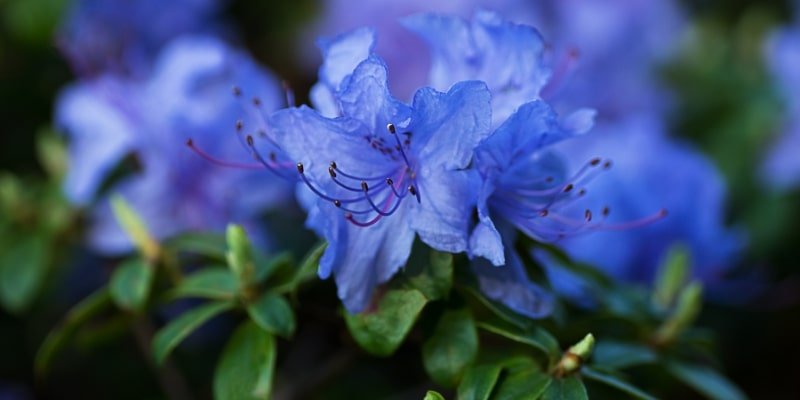
Scientific name: Rhododendron
USDA zone: 3 to 9
Plant Size: 1-2 feet tall
Sun Exposure: partial sun full shade
Azaleas are typically low-maintenance plants that, given the proper care and planting position, may flourish in most yards. Azaleas can live for many years or longer if given the right care. Gorgeous blooms that are quite striking and welcome in the spring garden. The azalea bloom is available in orange, red, pink, or white. Acidic, well-drained, biologically rich soil that doesn’t stay too wet or too dry is ideal for azaleas.
8. Catmint
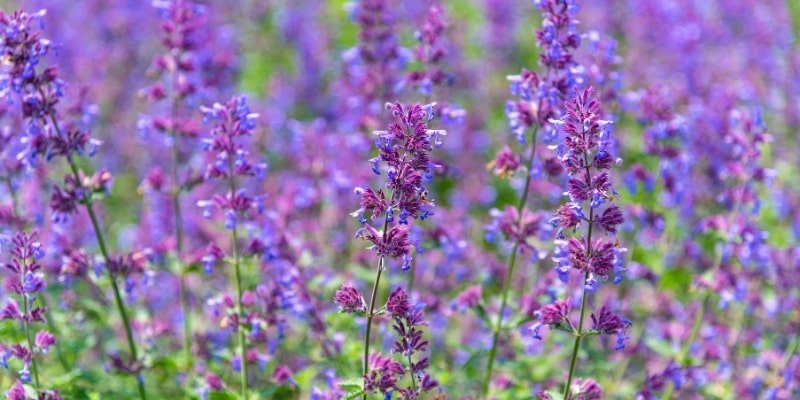
Scientific name: Nepeta cataria
USDA zone: 3 to 9
Plant Size: 1-3 feet
Sun Exposure: full to part sun
Nepeta plants are a great option for gardeners who like to enjoy the fragrant foliage and eye-catching blossoms of these low-maintenance perennials while also drawing pollinators. Nepeta plants are an excellent option if you own cats or are just seeking to add some colour and aroma to your landscape. These plants must be placed both visually wonderfully and closely enough to allow for proper air circulation.
9. Blazing star

Scientific name: Liatris spicata
USDA zone: 3 to 9
Plant Size: 1-3 feet
Sun Exposure: full sun
Bottlebrushes with beautiful purple blossoms, known as “blazing star flowers,” grow in late summer. Other names for them include button snakewort, gayfeather, and prairie feather.
Gayfeather, also known as Blazing Star, is a great wildflower for the sunny border. A neat little bundle of narrow leaves bolts to reveal long, thick flower spikes that resemble a bottlebrush. This elegant, towering beauty also makes lovely cut blooms! Thanks to its grassy green foliage and upright flower spikes, Gayfeather, is a special pollinator plant.
10. Dalmatian bellflower
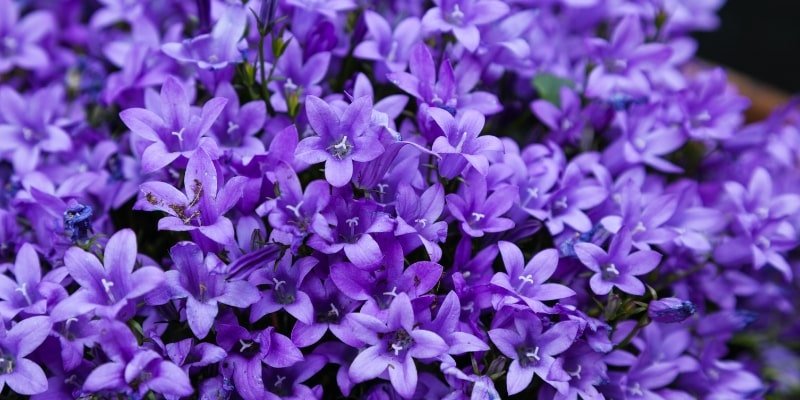
Scientific name: Campanula portenschlagiana
USDA zone: 4 to 8
Plant Size: 3-6 in. tall, 6-12 in. wide
Sun Exposure: full to partial shade
A tiny, bell-shaped purple flower covers the lime-green foliage of this trailing, creeping herbaceous perennial during the spring to early summer blooming season. Hummingbirds find this plant attractive, and it works well as a ground cover or space filler.
For the rock garden or hanging basket, Campanula portenschlagiana is a great plant. Little leaves of the Dalmatian Bell Flower give the tiny garden area a delicate feel. Regular irrigation and healthy soil are essential for this flower.
11. Golden Dewdrop
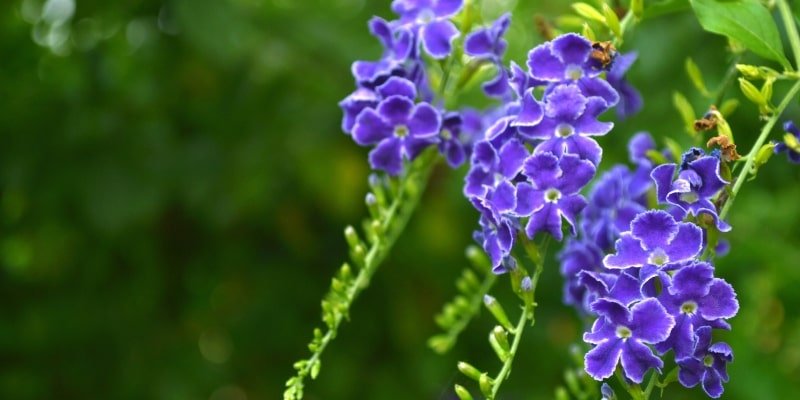
Scientific name: Duranta erecta
USDA zone: 3 to 11
Plant Size: 1.5-4 feet tall
Sun Exposure: full sun
With delicate purple blooms that attract butterflies and golden berry clusters so heavy they give the plant a beautiful, flowing appearance, golden dewdrop grows quickly and with a little bit of wildness. Because Duranta Erecta grows well in pots, it is an excellent choice for container gardening.
As a result, it can aid in improving outdoor areas, balconies, or interior areas. It is practical to use the Golden Dewdrop plant for landscaping on slopes because of its dense growth habit, which effectively prevents soil erosion.
12. Hebe
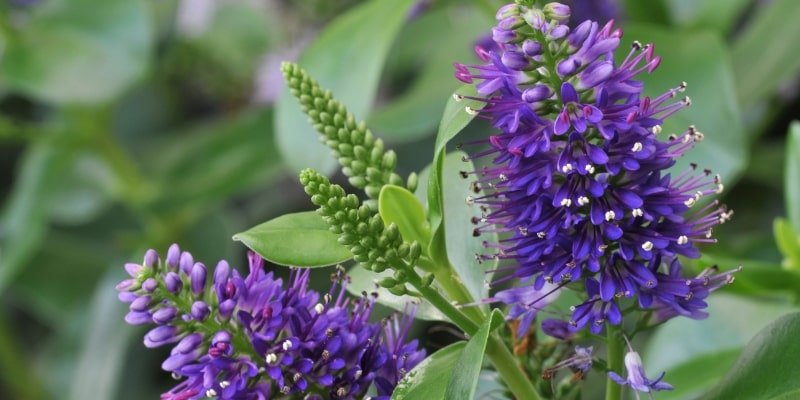
Scientific name: Veronica speciosa
USDA zone: 3 to 9
Plant Size: 1ft up to 4ft
Sun Exposure: full to part sun
Gardeners grow Attractive Hebe for its glossy foliage, rounded bushy form, and blooms. It is planted as a specimen in a garden along the sea or as a filler plant along borders in parks and gardens. Two years to develop and is also grown in large pots and tubs. It can be pruned like a hedge and needs just a little care. It requires little water once grown, making it ideal for coastal areas.
13. Leptodermis

Scientific name: Leptodermis oblonga
USDA zone: 5 to 8
Plant Size: 12 – 18 inches
Sun Exposure: full sun part sun
Blossoming apparatus! Wonderful but little-known, leptodermis is a shrub with a low mounding habit and tiny purple-violet blooms that start in late spring and last until frost. It’s kind of a suckering habit, which makes it perfect for enhancing big spaces.
Leptodermis oblonga is also referred to as the Chinese Violet. It is highly valued for its exquisite early summer lavender-blue blossoms. The plant is easy to cultivate in gardens and likes slightly shaded, moist soil. Additionally, leptodermis has medical qualities; plant extracts are used to treat a range of conditions, including hypertension and arthritis.
14. Magnolia ‘Anne’
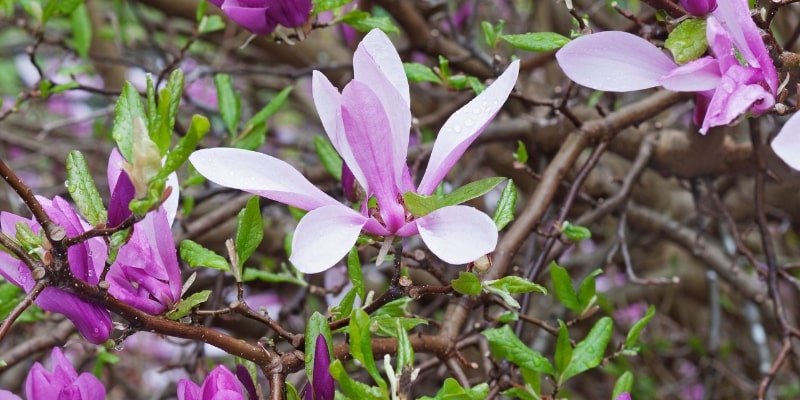
Scientific name: Magnolia x ‘Ann’
USDA zone: 4 to 8
Plant Size: 8-10 feet tall
Sun Exposure: full sun part shade
Large, leathery green leaves and fragrant purple-red blossoms feature Magnolia Ann, a shrub that blooms in the spring. The flowers are about 4 1/2 inches big and cup-shaped, with a faint aroma.
One of the most well-liked cultivars in the “Little Girl” magnolia collection is the Magnolia x “Ann,” which was created for its compact growth habit, later blooming time, and petite size. Because Magnolia Ann blooms in April and May, there’s a lower chance that a late-season frost would destroy any of the buds. Midsummer is when it might even rebloom.
15. Rose of Sharon

Scientific name: Hibiscus syriacus
USDA zone: 5 to 8
Plant Size: 6 to 11 feet tall
Sun Exposure: partial to full sun
Hibiscus syriacus is a deciduous shrub with huge, spectacular flowers that resemble hollyhock blossoms. It is an exotic beauty. The Rose of Sharon cultivates best in well-draining, nutrient-rich soil that has a pH range of slightly acidic to neutral.
Take care when planting rose of Sharon to prevent wild seedling dispersal. In certain areas of the US, it is regarded as invasive, therefore make sure before planting.
16. Tea Rose

Scientific name: Rosa x hybrida
USDA zone: 5 to 9
Plant Size: 2-8 feet tall
Sun Exposure: full sun
As decorative blooming deciduous shrubs, hybrid tea roses belong to the Rosaceae, or rose family. This shrub features tall, straight stems with huge, high buds. Typically, each stalk produces just one flower.
Your gardens will look more interesting because of the various colours and scents. When applied as cut flowers, they create beautiful floral displays.
17. Weigela
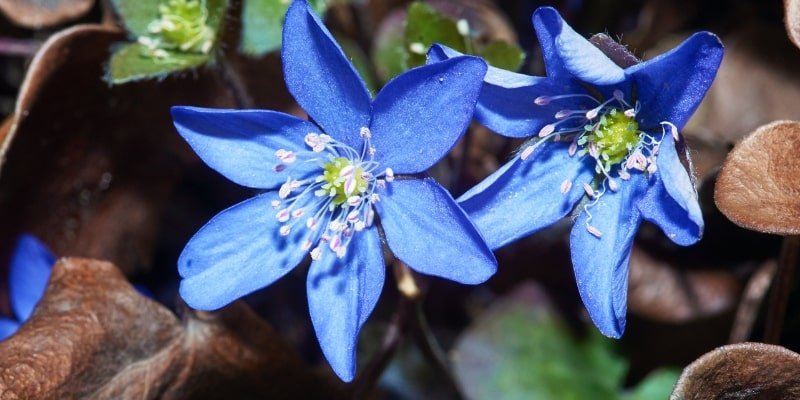
Scientific name: Weigela Florida
USDA zone: 4 to 8
Plant Size: 4-8 feet tall
Sun Exposure: full sun
The weigela is a compact, low-lying shrub that has narrow, teardrop-shaped green leaves and tiny, tubular flowers. It’s possible that the shape of the flowers relates to honeysuckle.
Weigela comes in vivid pink-purple hues.
These purple-flowering shrubs attract hummingbirds and butterflies. In the spring and summer, you can admire their blooms. As long as the soil is damp and well-drained, they can thrive in a variety of soil types. Although pruning is advised once the first buds form, it might not be necessary.
18. Paperflower

Scientific name: Bougainvillea glabra
USDA zone: 7 to 12
Plant Size: 2-3 feet tall
Sun Exposure: partial shade full sun
The Bougainvillea plant is not just colourful but also incredibly adaptable. It looks great in any arrangement, whether it is planted as bonsai, in big pots, or in hanging baskets. It just needs lots of sunshine and well-draining soil to sustain its distinctive, colourful foliage and encourage new growth.
In places with mild winters, paper flowers bloom all year round. Otherwise, it blossoms from spring to autumn.
19. Daphne Marianni
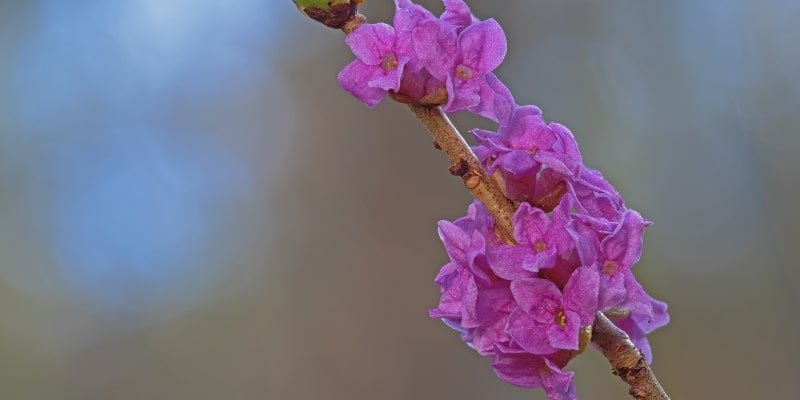
Scientific name: Daphne odora
USDA zone: 6 to 10
Plant Size: 3-4 feet tall
Sun Exposure: full to partial shade
Marianni is a rounded, evergreen shrub that is borderline hardy. It bears spherical clusters of fragrant, tubular, pink flowers in late winter and early spring, along with leathery, glossy, dark green leaves with broad, yellow borders.
Daphne Marianni’s tall, glossy leaves with their bands of green and yellow will adorn your yard. The leaves are cantered on spherical clusters of gorgeous, velvety blooms. The fragrant white blossoms with a hint of pink or pastel purple. The lovely display of tubular buds with petals shaped like stars will captivate you.
20. Cutleaf Lilac

Scientific name: Syringa x laciniata
USDA zone: 4 to 8
Plant Size: 6-8 feet
Sun Exposure: full sun
The tall flowering spikes of pinkish-lavender star-shaped flowers open from the bottom to the narrow tapering tips, and the gorgeous green foliage provides the ideal counterpoint! Delivering tasteful, long-lasting flowers to you for weeks!
The best part is that you won’t miss a moment of that timeless lilac aroma! Cut leaf will tolerate both heat and cold, and lilacs require very little maintenance.
21. Crapemyrtle
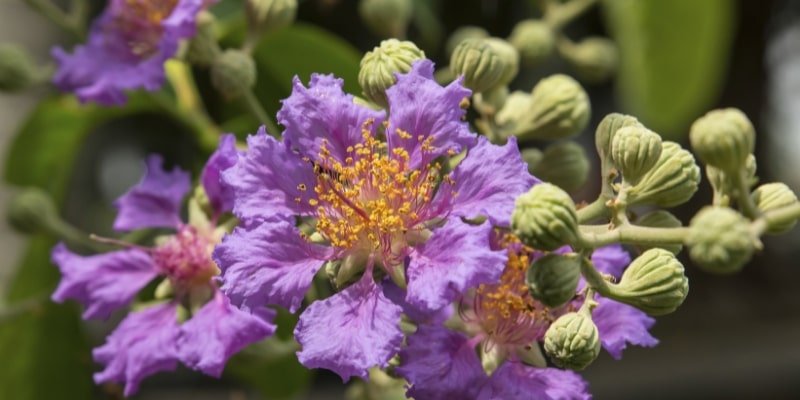
Scientific name: Lagerstroemia
USDA zone: 6 to 9
Plant Size: 15-25 feet
Sun Exposure: full sun
Lagerstroemia sometimes referred to as crepe myrtle, is a visually arresting and adaptable deciduous tree or shrub that is prized for its decorative bark, range of sizes and shapes, and bright and protracted flowering period.
Because of its easy maintenance requirements and appeal throughout the year, this plant is a favourite in many landscapes. Beyond being beautiful, crepe myrtle plants require little care, can withstand pollution and drought, and attract bees for pollination.
22. Abelia
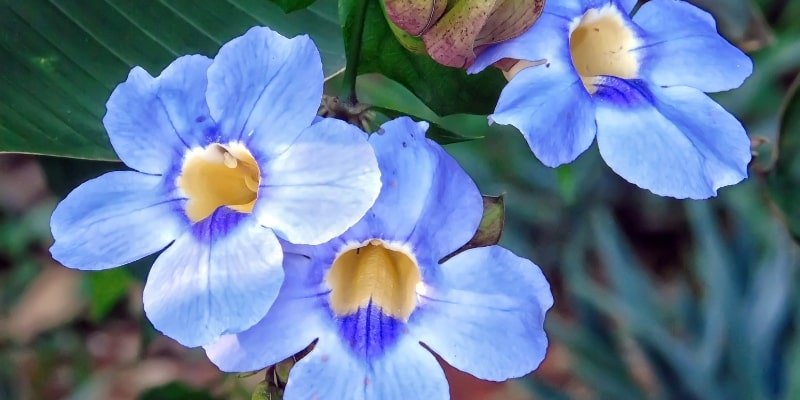
Scientific name: Linnaea x grandiflora
USDA zone: 4 to 9
Plant Size: 3-6 ft. tall
Sun Exposure: full sun to part shade
Shrubs like Abelia are capable of producing flowers in shades of pink, peach, and of course purple. You will love the fragrant, spicy-sweet purple blooms that appear in late spring and the vibrant foliage that turns colourful in the fall.
Additionally, they yield seed pods that will draw a variety of birds and butterflies to your grass. You can grow a variety of Abelia species, many of which are hardy in cold climates. If you can enjoy its fragrant blossoms, it does well as a specimen or border planting!
23. Beautyberry
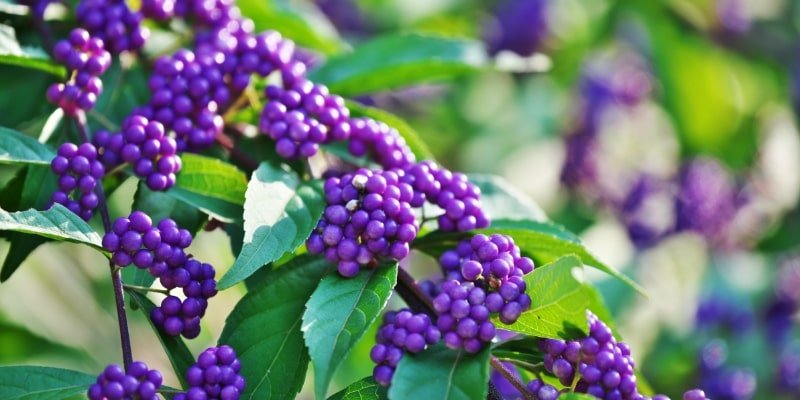
Scientific name: Callicarpa Americana
USDA zone: 5 to 8
Plant Size: 4-8 foot
Sun Exposure: partial sun
The purple berries that grow on the stems in the fall will be what attract your attention, even though the beautyberry is a shrub with white blossoms in late summer. This gorgeous shrub offers purple in several ways because it has black-purple foliage on multiple types of beautyberry. with popular purple cultivars such as “Purple Pearls” and “Pearl Glam.”
24. Geranium

Scientific name: Pelargonium
USDA zone: 3 to 9
Plant Size: 10 to 11
Sun Exposure: sun
The “geranium” is not a true member of the genus Geranium. For botanists and gardeners, a “geranium” is a perennial shrub that can withstand the winter. Experts refer to the well-known summer bloomers that we all know and adore as “pelargoniums,” which furthers the confusion.

